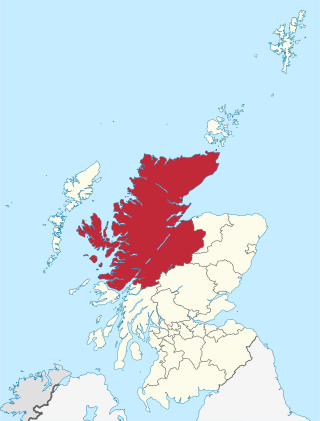
Highland is a council area in the Scottish Highlands and is the largest local government area in the United Kingdom. It was the 7th most populous council area in Scotland at the 2011 census. It shares borders with the council areas of Aberdeenshire, Argyll and Bute, Moray and Perth and Kinross. Their councils, and those of Angus and Stirling, also have areas of the Scottish Highlands within their administrative boundaries.

Fortrose is a town and former royal burgh in Highland, Scotland, United Kingdom. It is located on the Black Isle, a peninsula on the Moray Firth. It is about six miles northeast of Inverness. The burgh is a popular location for trying to spot bottlenose dolphins in the Moray Firth. The town is known for its ruined 13th century cathedral, and as the home of the Brahan Seer.
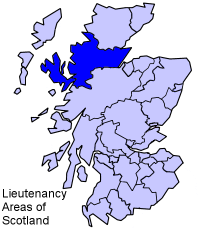
Ross and Cromarty, also referred to as Ross-shire and Cromartyshire, is a variously defined area in the Highlands and Islands of Scotland. There is a registration county and a lieutenancy area in current use, the latter of which is 8,019 square kilometres in extent. Historically there has also been a constituency of the Parliament of the United Kingdom, a local government county, a district of the Highland local government region and a management area of the Highland Council. The local government county is now divided between two local government areas: the Highland area and Na h-Eileanan Siar. Ross and Cromarty border Sutherland to the north and Inverness-shire to the south.
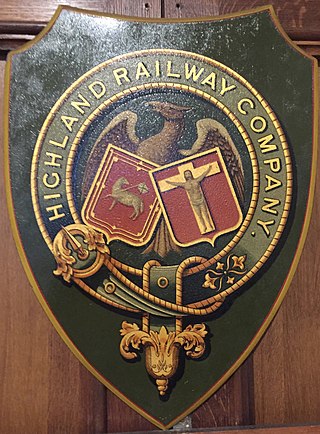
The Highland Railway (HR) was one of the smaller British railways before the Railways Act 1921, operating north of Perth railway station in Scotland and serving the farthest north of Britain. Based in Inverness, the company was formed by merger in 1865, absorbing over 249 miles (401 km) of line. It continued to expand, reaching Wick and Thurso in the north and Kyle of Lochalsh in the west, eventually serving the counties of Caithness, Sutherland, Ross & Cromarty, Inverness, Perth, Nairn, Moray and Banff. Southward it connected with the Caledonian Railway at Stanley Junction, north of Perth, and eastward with the Great North of Scotland Railway at Boat of Garten, Elgin, Keith and Portessie.

The Kyle of Lochalsh line is a primarily single-track railway line in the Scottish Highlands, from Dingwall to Kyle of Lochalsh. Many of the passengers are tourists, but there are also locals visiting Inverness for shopping, and commuters. All services are provided by ScotRail and run beyond Dingwall to Inverness. In the past there were some through services to and from Glasgow, Edinburgh or Aberdeen. None of the line is electrified, and all trains on the line are diesel-powered, as are all other trains in the Scottish Highlands.
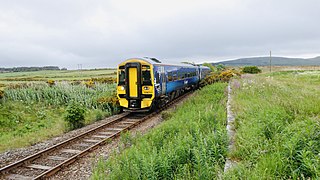
The Far North Line is a rural railway line entirely within the Highland area of Scotland, extending from Inverness to Thurso and Wick. As the name suggests, it is the northernmost railway in the United Kingdom. The line is entirely single-track, with only passing loops at some intermediate stations allowing trains to pass each other. In common with other railway lines in the Highlands and northern Lowlands, it is not electrified and all trains are diesel-powered.
The Black Isle is a peninsula within Ross and Cromarty, in the Scottish Highlands. It includes the towns of Cromarty and Fortrose, and the villages of Culbokie, Resolis, Jemimaville, Rosemarkie, Avoch, Munlochy, Tore, and North Kessock, as well as numerous smaller settlements. About 12,000 people live on the Black Isle, depending on the definition.

Ross, Skye and Lochaber is a constituency of the House of Commons of the Parliament of the United Kingdom (Westminster). It elects one Member of Parliament (MP) by the first past the post system of election.
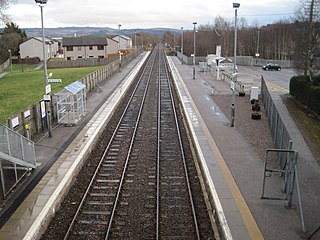
Muir of Ord railway station is a railway station on the Kyle of Lochalsh Line and the Far North Line, serving the village of Muir of Ord in the Highland council area of Scotland. The station is 13 miles 4 chains from Inverness, between Beauly and Conon Bridge, and is the location of the sole remaining passing loop on the single line between Dingwall and Inverness.

Fortrose was the terminus of a single track branch of the Highland Railway in north east Scotland. It connected villages in the Black Isle peninsula to the railway network via a junction at Muir of Ord.
The IV postcode area, also known as the Inverness postcode area, is a group of 52 postcode districts for post towns: Achnasheen, Alness, Avoch, Beauly, Bonar Bridge, Cromarty, Dingwall, Dornoch, Elgin, Fochabers, Forres, Fortrose, Gairloch, Garve, Invergordon, Inverness, Isle of Skye, Kyle, Lairg, Lossiemouth, Muir of Ord, Munlochy, Nairn, Plockton, Portree, Rogart, Strathcarron, Strathpeffer, Strome Ferry, Tain and Ullapool in north Scotland.

The A835 is a road in the Scottish Highlands linking Inverness to Ullapool and the Far North of Scotland.
The Inverness and Ross-shire Railway was a Scottish railway company formed in 1860 to build a line from Inverness to Invergordon. It opened in 1862 as far as Dingwall and in 1863 to Invergordon. It was extended to a Bonar Bridge station in 1864. It provided the basis for later extensions that eventually reached Thurso, forming the Far North Line. The Dingwall and Skye Railway branched off at Dingwall to reach the Kyle of Lochalsh.
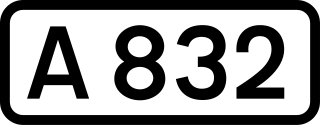
The A832 is a road in the Scottish Highlands, linking Cromarty, on the east coast, to Gairloch on the west coast, and beyond Gairloch to Braemore Junction. It is 126 miles (203 km) long and runs entirely in the former county of Ross and Cromarty. The road forms part of the Wester Ross Coastal Trail.
The Inverness and Aberdeen Junction Railway (I&AJR) was a railway company in Scotland, created to connect other railways and complete the route between Inverness and Aberdeen. The Inverness and Nairn Railway had opened to the public on 7 November 1855 and the Great North of Scotland Railway (GNoSR) was building from Aberdeen to Keith. The I&AJR opened, closing the gap, on 18 August 1856.
The Cromarty and Dingwall Light Railway was a never-completed light railway linking Cromarty in the Black Isle, Ross and Cromarty, Scotland to the Highland Railway system at Conon.
The Buckie and Portessie Branch was a railway branch line in Scotland, built by the Highland Railway to serve an important fishing harbour at Buckie, in Banffshire. It connected with the rival Great North of Scotland Railway at Portessie.

Avoch railway station was a station on the single track branch of the Highland Railway, in north east Scotland. The line connected villages in The Black Isle peninsula to the railway network via a junction at Muir of Ord.

The Inverness and District Football Association runs amateur football around the city of Inverness, in the Highlands of Scotland. They are affiliated to the Scottish Amateur Football Association.
The Far North Line was built in several stages through sparsely populated and undulating terrain. Extending to 161 miles (259 km), it runs north from Inverness to Wick and Thurso in Caithness, and currently carries a regular passenger train service.














